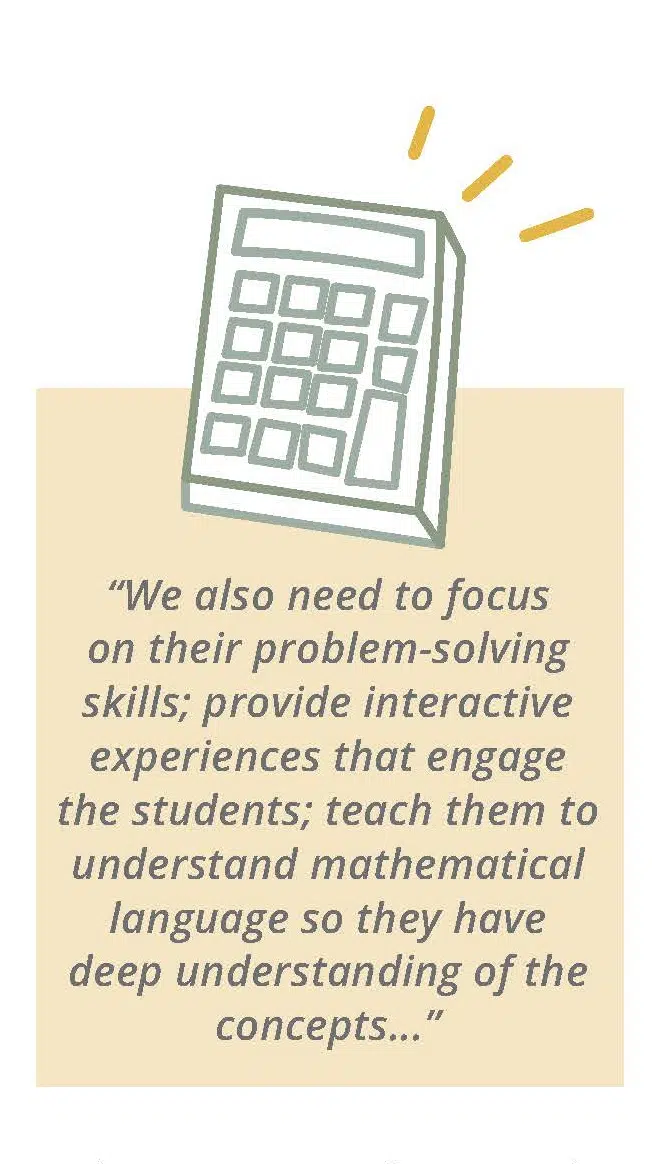Calculating the Future
Calculating the Future
CISE Partners with Hamilton County Educational Services to Design Math Curriculum and Give Schools a Boost
by Eileen Connelly, OSU
Ask Kal’el, a sixth grader at Corryville Catholic School, how he feels about math, and he cheerfully responds, “I like studying it and solving problems.” That wasn’t always the case, but thanks to a collaborative effort between CISE and Hamilton County Educational Services (HCES), students like Kal’el are recognizing that math can indeed be fun and useful.
CISE currently serves students at 10 schools in Cincinnati’s poorest neighborhoods and exists to improve the lives of children through quality Catholic education, transforming lives and rewriting futures. The non-profit organization partnered with HCES in 2018 to improve mathematical instruction and address performance issues on state and local mathematical assessments.
Based on assessment, HCES designed a consistent curriculum and a pacing guide for Kindergarten through the eighth grade that align with Ohio mathematical standards, archdiocese graded course study, IOWA test and the entrance exam for eighth graders into Catholic high schools. Resources for each school’s text books, initiatives and electronic supports were also made available, and curriculum guidance geared toward creating uniformity, yet reflecting each school’s uniqueness, has been provided. In addition, teaches have been given professional development opportunities, and Veronica Diaz and Elizabeth Sewell, HCES school improvement specialists and math coaches, have been working with them in their classrooms.
 “Our goal is to make sure that the learning standards are the focus of student needs,” Diaz said. “A lot of students struggle with abstract mathematics and need more than paper and pencil to learn. That’s important, but we also need to focus on their problem-solving skills; provide interactive experiences that engage the students; teach them to understand mathematical language so they have deep understanding of the concepts, rather than just one concept after another; and show them how math connects to everything they do.”
“Our goal is to make sure that the learning standards are the focus of student needs,” Diaz said. “A lot of students struggle with abstract mathematics and need more than paper and pencil to learn. That’s important, but we also need to focus on their problem-solving skills; provide interactive experiences that engage the students; teach them to understand mathematical language so they have deep understanding of the concepts, rather than just one concept after another; and show them how math connects to everything they do.”
“I’ve had the pleasure of working with many amazing teachers, students, and administrators,” Diaz added. “Their passion and desire to improve math achievement and outlook are evident as they share a willingness to try new strategies and activities to enhance student success. The goal is to make math visible, engaging, so the kids learn to love math and thrive in it. Hearing students say, ‘I now like math!’ or ‘I now understand math better!’ is priceless.”
Lauren Clements, principal at Corryville Catholic explained the need for the program. “Our math scores had just been lower than we wanted them to be and weren’t showing a lot of growth,” she said. “We’ve seen a tremendous impact through this partnership: support for the teachers, planning with the math coaches, the best instructional strategies, and the skills needed most at each grade level.”
Clements added, “Our teachers all follow the same framework from year to year, so the consistency is going to be there with concept development. The students will know what to expect and won’t lose the concepts they’ve mastered.”
The collaboration has yielded impressive results thus far. For example, on the IOWA test, four of the five grade levels analyzed had at least 60-percent of the CISE schools showing an increase in the Math National Percentile rank of average standard scores for 2019-2020.
CISE Executive Director Mabe Rodriguez expressed her gratitude to the C. Schott Foundation, Marge and Charles J. Schott Foundation and Barry Bucher for supporting the program. The goal moving forward, she said, “is to keep this program on an ongoing basis and continue increasing the academic performance in CISE schools. The better academically prepared our CISE scholars leave grade school, the higher chance of success they have in high school and beyond.”
“We want our students to succeed in high school and college, to be competitive, and they need strong math scores for that,” Clements said.
“We want them to feel empowered, confident, and excited about math. If we change how they feel about math early, then we’ll have done our job.”
Kal’el’s change of attitude about math and newfound confidence says it all: “I didn’t like math when I started the fifth grade last year. The new stuff was hard to understand, and I forgot about it. It really helped to have it written down and explained. Now I get it, and I like it!”
This article appeared in the August 2021 edition of The Catholic Telegraph Magazine. For your complimentary subscription, click here.













